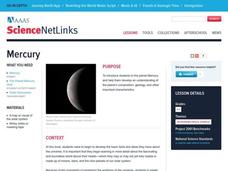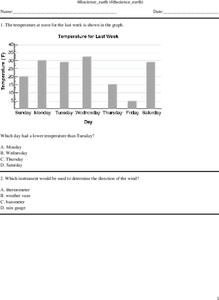Curated OER
Modeling Shadows
Learners demonstrate understanding of shadows by creating a physical model of concepts taught.
Curated OER
Telling Stories About Ourselves
Students discover how visual images communicate meaning. They create costumes that tell personal stories and perform dances wearing the costumes.
Curated OER
The Impact
Students study different inventors and inventions. In this invention introduction instructional activity students pretend that they are an inventor and come up with their own invention.
American Museum of Natural History
A Closer Look at Mars
A website looks at how we know so much about Mars—telescopes, robots, and spacecraft—and the search for martian life. Following the informational text are three questions that quiz pupils about possible life on Mars.
Curated OER
Count by 5s, 10s, and 100s
There's an easier way to count! Scholars get practice counting by 5 and 10 in this skip-counting activity. There are 10 problems, and for each they observe a set of objects that have been grouped. Learners skip count to get a final...
Curated OER
Chandra Explores Angular Size
In this angular size learning exercise, students read about how astronomers determine the size of objects in the sky by using their angular size. Kids are given equations that allow scientists to convert the angular size into kilometers....
Curated OER
Mercury
Middle schoolers study the planet Mercury and develop an understanding of the planet's composition, geology, and other important characteristics. They explore a Web resource on the planet Mercury which is the central focus of this lesson...
Curated OER
Earth Science
In this Earth science worksheet, 4th graders answer multiple choice questions about temperature, weather instruments, heat, light, and more. Students complete 25 questions.
Curated OER
Our Changing View of the Solar System
Students identify and name the eight planets and the five dwarf planets in our solar system. In this space science lesson, students view a slideshow of the planets and label them on an included Solar System chart.
Curated OER
The Sun
Middle schoolers draw diagram of sun and its layers, including photosphere, chromosphere, corona, convection and radiative zones, and core. Students then describe each layer in their own words, define sun spot cycle, and describe solar...
Curated OER
Space Science: Journey Through the Solar System
Learners explore the Solar System and examine the characteristics of al the planets. Through research and discussion, they create catalogs of the Solar System's components. Next, students use their findings to create Powerpoint...
Curated OER
Timekeeping by the Sun
Students measure shadows to learn about the Sun-Earth relationship. In this astronomy lesson, students create a shadow stick of a Pokemon character and record measurements of its shadow in a data chart. Follow-up discussions guide...
Curated OER
Space Science
Eighth graders study the objects in our solar system. In this space instructional activity students identify and describe planets, then classify them as terrestrial or gaseous.
Curated OER
Spotting an Approaching Asteroid or Comet
In this asteroid and comet worksheet, students read about the formula used to determine the brightness of asteroid. They apply this formula to solve 2 problems about asteroids and their brightness.
Curated OER
How Many Quasars Are There?
In this quasars activity, students read about how astronomers can detect quasars by their luminosity. Students use a given equation to solve 4 problems including finding quasar magnitude, determining the number of quasars with given...
Curated OER
Foucault's Pendulum
Students investigate how the motion of the Foucault pendulum proves that the Earth is rotating. They research the Internet about pendulums and conduct an experiment online. They view a multimedia presentation about pendulums and read...
Curated OER
Heliocentric and Geocentric Models
In this worksheet, students read an informational article and view drawings of the two models. In this comprehension worksheet, students answer twelve questions.
Curated OER
Kepler-The Hunt for Earth-like Planets
In this hunt for planets activity, students read about the Kepler satellite used to detect exoplanets. Students solve 6 problems including drawing a sun disk and determining the scale in kilometers/millimeter, finding the area of the Sun...
Curated OER
When a Ruler is Too Short
Learners measure distances using parallax. In this math lesson, students explain how this method helped astronomers with their studies of the solar system. They determine the length of their arm using parallax and compare it with other...
Curated OER
Gravity Gets You Down
Learners investigate the force of gravity and how it effects different objects that are put into acceleration when applied the experiment of free falling. They drop different objects that have a variety of masses and some that cause air...
Curated OER
Nebular Theory-Origin of the Solar System
In this Nebular Theory worksheet, students are given diagrams of the stages that occurred in the formation of the solar system. They order the diagrams based on the occurrences of each event and answer twelve questions about the Nebular...
Curated OER
Galileo Galilei Questions for Study
In this online interactive philosophy worksheet, students respond to 10 short answer and essay questions about Galileo's contributions to science.
Curated OER
Our Place in Space
Third graders identify the different planets that make up the solar system. In this space science lesson, 3rd graders construct a scale model of the major planets. They explore their different unique features and dress up as planets.
Curated OER
The Little Fluffy White Cloud
In this reading comprehension worksheet, learners read, analyze and interpret the short story "The Little Fluffy White Cloud" and then answer eighteen comprehension questions about the short story.
Other popular searches
- Sun Moon Stars
- Sun Moon and Stars
- Sun, Moon, Stars
- Sun, Moon and Stars
- Sun Moon and Stars Activity
- Earth Moon and Stars
- Stars and Moon
- Identifying Sun Moon Stars
- Observing Moon and Stars
- Sun, Moon, and Stars
- Earth, Moon and Stars























